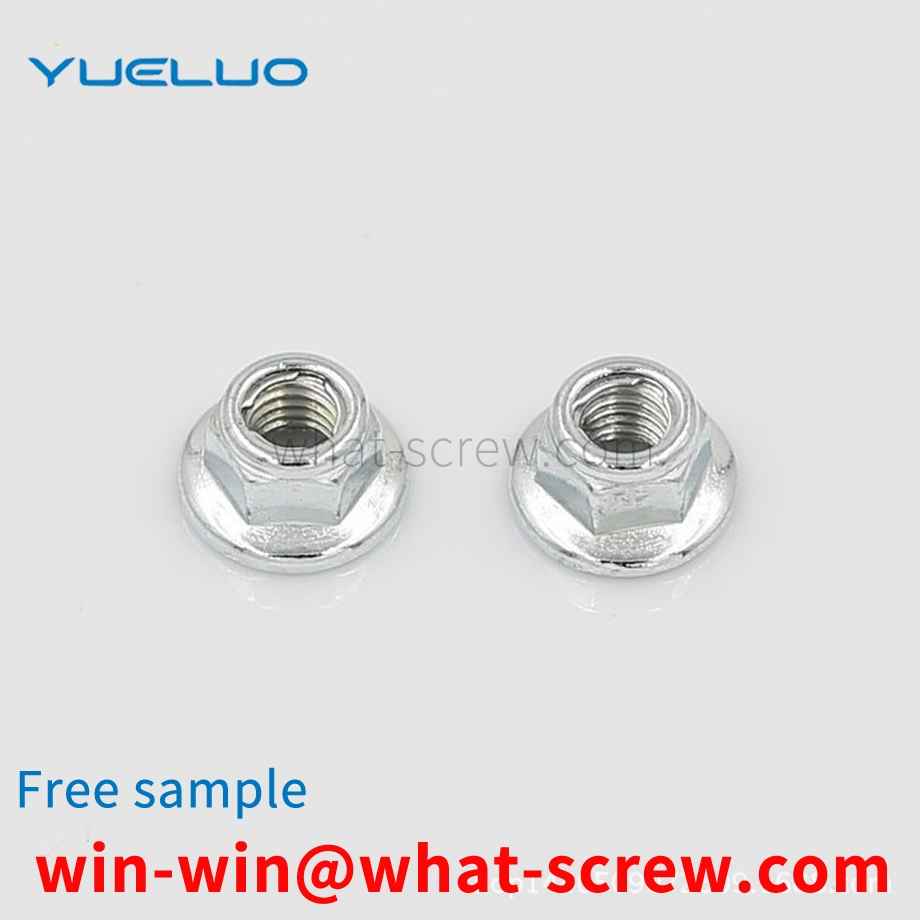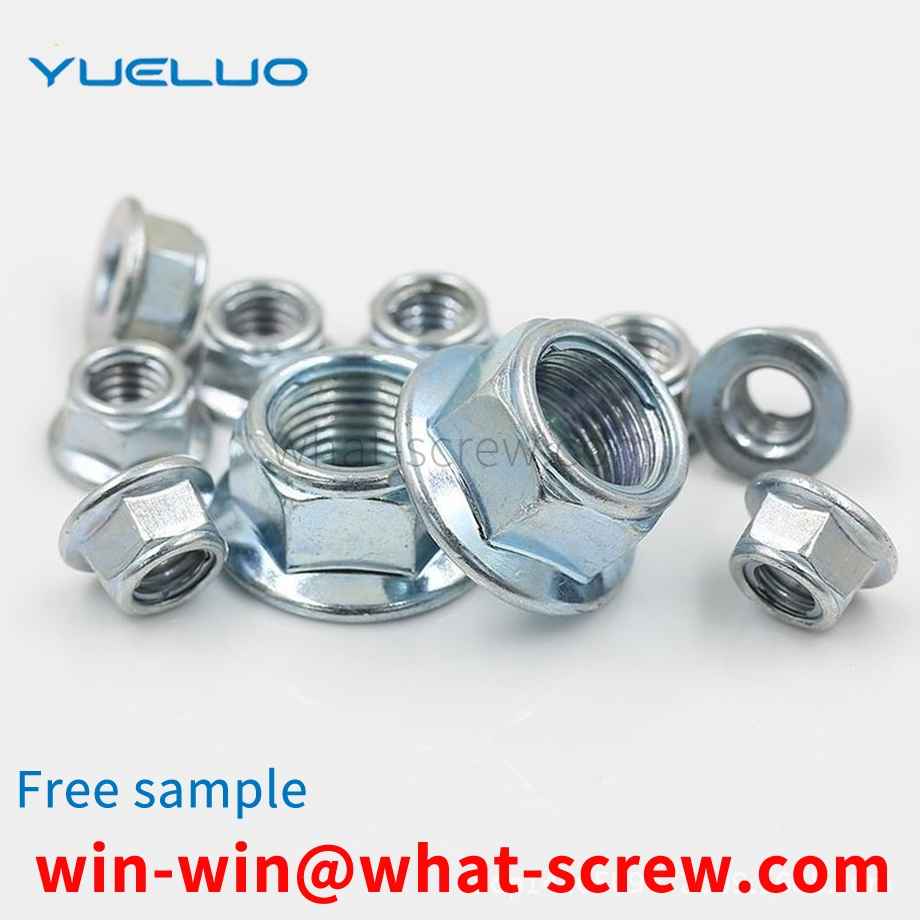At present, the washing machines used in the domestic market, especially the large-capacity washing machines, have high rotational inertia due to their large washing capacity. The wear between the input shaft and the clutch sleeve will cause the increase of the axial clearance. There will be strong shaking and loud noise, which will increase the wear and tear and affect the service life. In the prior art, the wave washer is used to prevent loosening and buffer shock, so that the gap between the input shaft and the clutch sleeve will not increase due to the wear of the two, which plays the role of automatic gap compensation, so as to ensure the clutch Smooth rotation, low noise and light wear ensure the reliable service life of the clutch.
total of 13 domestic automotive fastener companies were interviewed and investigated in this survey, and all the companies under investigation have passed the TS16949 system certification. An average car has about 1500 fasteners, and the total bolt assembly time for each car is about 2.5~3.2h. It can be seen that the variety and quality of fasteners have an important impact on the level of the main engine and the quality of the vehicle. This article analyzes the localization of high-strength threaded fasteners and the management of supply quality from the perspective of the production process of high-strength threaded fasteners. Product flow of high-strength threaded fasteners The production process of high-strength threaded fasteners is raw material transformation → cold heading forming → thread processing (thread rolling or thread rolling) → heat treatment → surface treatment → sorting and packaging, generally used above grade 10.9 Thread rolling process after heat treatment. The steel grades commonly used for high-strength bolts of automotive fastener materials are 35 steel, 45 steel, and ML35 steel for grade 8.8 bolts; 35CrMo for grade 10.9 bolts; 40Cr; 35CrMo, 42CrMo, and SCM435 for grade 12.9 bolts. The raw materials for domestic fasteners are basically in the hot-rolled state, while the steel for fasteners produced in Japan and other countries is basically in the state of direct cold heading. Users do not need pretreatment, which can reduce costs from the link. Common failure modes of fastener failure are assembly elongation, fatigue fracture, and delayed fracture. In addition to the material, the quality of cold heading forming and thread processing (thread rolling or thread rolling, tapping) threaded fasteners, forming equipment and thread processing equipment and molds (production process and equipment) are the key factors to ensure their quality. Especially in the state of large-scale and multi-variety supply, automotive fasteners that require high machining accuracy, how to ensure product consistency and defect prevention is one of the problems faced by fastener production. For the cold heading equipment and thread processing equipment of the investigated companies, domestic equipment accounts for about 40%, Taiwan equipment accounts for 50%, and imported (Europe, America, Japan) equipment accounts for about 10%; Partial folding, thread streamline upsetting, tooth wrinkles and cracks, etc. Domestic fastener factories are limited by capital or other reasons, and most of them use domestic equipment and Taiwan equipment to produce fasteners for automobiles. To ensure the dimensional tolerance and geometric tolerance of large-scale production of high-end fastener products, online monitoring should be increased. Means and mold making level. Eliminate unqualified products in production, so as to ensure the assembly quality of OEMs and OEMs. [1] About 80% of the surveyed fastener enterprises have heat treatment equipment, and most of them use Taiwan heat treatment process lines; the process line equipment is a continuous mesh belt furnace with atmosphere protection, and the atmosphere, temperature and process parameters are controlled by a computer. The high-strength fastener industry is a relatively competitive industry. If we want to have a thorough and objective analysis of the technology and market of the high-strength fastener industry, we need to start from the following aspects: domestic high-strength fasteners Industry and Enterprise Competition Pattern High-strength Fastener Industry Industrial Policy High-strength Fastener Product Technical Standards and Regulations my country's High-strength Fastener Product Technology Competition Pattern Dynamics Regarding these six aspects, many domestic research institutions have conducted in-depth research and research, and many institutions have long been engaged in research and research in this industry.
The fixing screw proposed by Guangdong Yueluo Hardware Industry Co., Ltd. has a screw body 1, and the axial surface of the screw body 1 is formed with extending screw teeth 6, and the axial surface is a column along the central axis direction of the cylinder of the screw body 1. The body surface has a hemispherical screw tail 7 at the bottom, and a screw head 2 at the top. The upper surface of the screw head 2 is provided with a slot (not shown). The screw body 1 is composed of the upper tapered rod 4 and the lower cylindrical screw 5. The tapered rod 4 is an inverted cone, the diameter of its circular upper surface and the diameter of the screw mounting hole 10. equal. The fixing screw also has a washer 3, the washer 3 is arranged between the screw head 2 and the screw body 1, the lower surface of the cylindrical washer 3 has a number of teeth 8, the teeth 8 are along the The upper surface of the inverted cone of the tapered rod 4 and the edge of the washer 3 are connected to form a straight convex strip 15 extending outward; the convex strip 15 can also be designed in an arc shape. The fixing screws for installation proposed by Guangdong Yueluo Hardware Industry Co., Ltd. can be made of metal materials in one piece. As shown in Figure 3, it is a schematic diagram of the installation of Guangdong Yueluo Hardware Industry Co., Ltd. for PCB board fixing. When installing, first pass the screw body 1 of the fixing screw through the mounting hole 10 and the copper column 11 provided on the PCB board 9, so that the tail 7 of the screw reaches the mounting hole 13 on the casing 12, and then use the tightening tool 14 to insert the screw At the notch on the top of the head, forcefully press the inverted cone design taper rod 4 of the screw body 1 into the mounting hole 10, so that the tail 7 passes through the mounting hole 13. Due to the outer diameter D at the bottom of the taper rod and the screw mounting hole The aperture size of 10 is equal, and the fixing screws are pressed and fixed, so that the PCB board 9 can be automatically corrected in the process of fixing its front, back, left and right deflections, and the accuracy of the installation position of the PCB board 9 can be ensured. As shown in Figure 4, after the fixing screw is screwed into the casing, the washer 3 is fully contacted and pressed on the PCB board 9, and the PCB board 9, the copper column 11 and the casing 12 are firmly connected together without sliding. . The teeth 8 on the washer 3 are in full contact with the surface of the PCB board 9, so that a ground wire path is set up between the PCB board 9 and the casing 13 by the metal fixing screw 1, thereby ensuring that the PCB board 9 is fully grounded , the design of the teeth 17 on the washer 3 also has a non-slip function. The fixing screws for installation designed by Guangdong Yueluo Hardware Industry Co., Ltd. make use of the cooperation, friction and electrical conductivity in the mechanical connection, which fully guarantees the firm installation of the PCB board and the chassis and the good grounding of the PCB board. Moreover, the ellipsoid tail of the fixing screw The surface is relatively smooth, even if the mounting holes are exposed, it will not cause scratches on the hands and desktop. The above is only the embodiment of Guangdong Yueluo Hardware Industry Co., Ltd., and does not limit the scope of Guangdong Yueluo Hardware Industry Co., Ltd., any equivalent structure made by using the contents of the description and drawings of Guangdong Yueluo Hardware Industry Co., Ltd. or etc. Effective process transformation, or direct or indirect application in other related technical fields, are also included in the protection scope of Guangdong Yueluo Hardware Industry Co., Ltd.
hand screw is a screw with a plastic head, and the user fixes the hand screw by turning the plastic head by hand. At present, a hand-tight screw is disclosed in the market publication number CN202203253U, which includes a plastic head and a screw rod, the plastic head and the screw rod are connected together, and the height of the plastic head is higher than that of an ordinary screw, and the height is 7cm. The screw of the hand screw is fixed in the plastic head by glue. After a period of use, the aging of the glue leads to the loosening of the screw and the plastic head. When the plastic head is stressed, the screw rod comes out of the plastic head, which affects the normal use of the hand screw.
Standards are norms, and each country and sector has its own standards. GB—Chinese National Standard (National Standard) ANSI—American National Standard (American Standard) DIN—German National Standard (German Standard) ASME—American Society of Mechanical Engineers Standard JIS—Japanese National Standard (Japanese Standard) BSW—British National Standard GB—National Standard The standard is one of the many standards in my country, and there are also industry standards, professional standards and department standards. National standards are divided into: GB (mandatory standards) and GB/T (recommended standards) and GBn (national internal standards) and so on. We usually see GB30, GB5783, etc. are mandatory standards. In addition to some basic dimensions such as head-to-side, head thickness, etc., the above standards are mainly different in the threaded part. The threads of GB, DIN, JIS, etc. are all in MM (millimeters), which are collectively referred to as metric threads. Another thread like ANSI, ASME, etc. is called American standard thread in inches. In addition to metric threads and American threads, there is also a BSW-imperial standard, whose threads are also in inches, commonly known as Wyeth threads. In the usual domestic sales business, the most common standards we encounter are GB (National Standard) and DIN (German Standard). In terms of production products, the following standards are mainly encountered: GB30; GB5783; GB5782; GB52; GB6170; GB818; GB819; GB845; GB846; GB70; DIN912; DIN933; DIN931 and so on. GB30 (old national standard) has been replaced by GB5783 (new national standard) in the standard book. GB52 (old national standard) has been replaced by GB6170 (new national standard) in the standard book.
We have many years of experience in the production and sales of screws, nuts, flat washers, etc. The main products are: screw hexagon screws, B1169 lifting ring nuts, 8.8 high-strength hexagon nuts, open-type flat head rivets and other products, we can provide you with products suitable for you fastener solutions.



















 Service Hotline
Service Hotline




